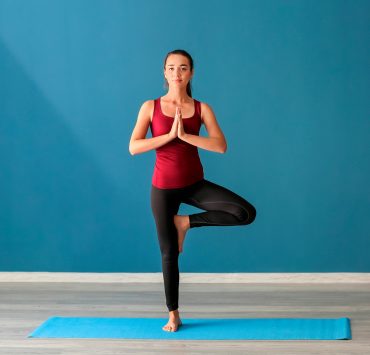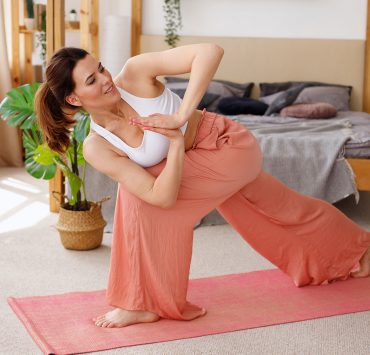
Paving the way for yogic living in Nebraska, Jacqueline Roberts…
Yoga is truly for everyone. The flexible and inflexible. The athletic and the stationary. The young the old. One of the best things about yoga is this unique feature: it can be adapted to suit anyone with any needs or challenges.
When it come to exercise for seniors, there may be no better choice than yoga. Because of its gentle and adaptive nature, yoga makes the perfect wellness routine for seniors of any age.
It’s no surprise that as we age, certain aspects of our bodies may become impaired. Some of us have trouble with joints or bones, cardiovascular issues, trouble standing or sitting, or other general ailments. Yoga poses can be adapted to suit all of these physical challenges, all while helping to improve the health and quality of life of the student.
Many seniors are looking for a gentle exercise routine to pick up to help stay active and prevent illness and injury later on. Yoga is that ideal activity that can keep seniors healthy long into their golden years. Let’s look at ten yoga poses that are key for maintaining health for seniors.
Yoga Benefits for Seniors

Yoga is well-known to have major health benefits for its practitioners. From physical strength and balance to mental clarity and peace, yoga offers a whole-person approach to wellness. These benefits hold true for seniors as well, with some added weight.
Move with Ease
Exercise is important at any age, but it is particularly important for seniors. Staying active is one of the most crucial ways to avoid injury and maintain your physical strength and abilities. A body in motion stays in motion, and that’s what we want as we grow older!
Yoga provides a gentle and low-risk exercise that can be done daily. Other high-intensity exercises like running, cycling, and weightlifting are great for keeping trim, but they can put too heavy a strain on muscles and joints. Low-impact exercise like Tai Chi and yoga provide a much safer and more sustainable way to maintain health.
Stay Flexible
Yoga naturally improves flexibility, as many of the poses are aimed at increasing range of motion, length of muscles, and fluidity of the joints. As we get older our range of motion and the suppleness of our muscles start to decrease. This leads to increased risk of falls and injury with simple daily activities. Maintaining our flexibility is important in preventing these injuries. Staying flexible empowers seniors to maintain their independence as well, allowing them to continue to do the daily activities they enjoy.
Keep Your Bones and Joints Healthy
Bones will naturally lose density (and therefore weaken) as we age. Similarly, joints become less supple and stiffer, leading to less motion and sometimes increased pain. By keeping a regular yoga practice, you can actually prevent the deterioration of your bones and joints. If you are already suffering from osteoporosis, the good news is that you can still practice yoga. In fact, yoga may help to relieve the symptoms of osteoporosis and improve joint tenderness. In these cases, it’s best to make use of yoga props to avoid any potential over-strain. Consider investing in yoga blocks, a strap, and an inflatable ball to enhance your yoga practice and stay safe during practice.
Maintain Mental Health
Yoga is like a secret weapon for maintaining a sharp mind and reducing fear, anxiety, and depression. Anyone can benefit from this power of yoga, but seniors may find this particularly useful. Some seniors start to experience mental health issues, increased depression, and fear about health and the future. Sleep disturbances are also common. Yoga has the ability to release these fears, anxieties, and worries. It can calm the mind and reduce the chatter of the mind. It improves the quality of sleep and provides a much-needed mental rest while on the mat.
10 Yoga Poses For Seniors
Tadasana — Mountain Pose

Stand tall with your feet together, keep your shoulders back, neck firm and straight, and tuck the chin slightly. Rest your arms by your side with palms facing in front of you. Engage your thigh muscles, lift your kneecaps, and envision a straight line connecting your pelvis to the top of your head. Connect to the ground beneath your feet.
Vrksasana — Tree Pose

Stand tall, with feet firmly on the ground in Mountain pose. Slightly shift your weight on to the left foot and lift the right foot slightly. Depending on your flexibility and state of balance, you can lift the right foot to the ankle, shin, or thigh. Keep your pelvis centered over the left foot to maintain balance and keep your gaze straight ahead. Bring your hands to prayer position in front of the heart. Breathe deeply while focusing your attention to the heart and chest. Take 5-10 breaths, slowly release your foot and return to mountain pose. Repeat with the opposite side.
Virasana — Hero Pose

Gently sit on your mat with your legs bent underneath, buttocks resting on feet. With your thighs perpendicular to the floor and inner knees touching, slide your feet out to the sides of your hips and keep them flat against the floor. On an exhale, sit back but lean your torso slightly forward. With your thighs perpendicular to the floor and inner knees together, slide your feet out to the sides of your hips and keep them flat against the floor. On an exhale, sit back but lean your torso slightly forward. If you suffer from knee problems, you may benefit from using a bolster or blanket underneath the buttocks to reduce the strain on the knees.
Marjaryasana — Cat-Cow Pose

Begin on your mat on all fours. Bend your knees bent directly below your hips and plant your palms firmly on the ground, resting right below your shoulders. Inhale and look up to the sky while gently bending your back. If you have back pain, bend only to feel a stretch, not pain or straining. Exhale and bring your back up, roll your shoulders, tuck your head down, and feel the spine open into Cow pose. Repeat several times, taking slow and easy breaths.
Adho Mukha Svanasana — Downward Facing Dog Pose

Come to the floors on hands and knees in a tabletop position. Use a blanket to comfort the knees if this is uncomfortable. With your hands and toes firmly planted on the ground, stretch the knees to come to a V-shape, into Downward Dog position. Start with the knees slightly bent and heels off the ground, then exhale and slowly straighten the legs bringing the feet fully to the ground if possible. Feel free to bend the knees and stretch the feet and ankles.Rest here for a few breath cycles.
Baddha Konasana – Cobbler’s Pose

Sit on your mat and bend your knees to bring the soles of your feet together. The knees will fall to the sides, like a butterfly. Bring the knees closer into the body until you reach a stretching, yet comfortable position. Be careful not to overstrain the knees. Press your feet together, potentially clasping them with your hands. Sit up with a tall spine and keep your shoulder blades down. Rest here for several full breath cycles.
Salamba Bhujangasana — Sphinx Pose

Start by laying face-down on your mat, with your arms by your side and your legs together. Point your toes back towards the wall behind you to activate the leg muscles. Move your arms so that your elbows are below your shoulders and your forearms straight out in front of you. Inhale and lift the chest and head to sphinx pose. Engage (but try not to clench too hard) the buttocks and legs. Draw the belly in slightly to reach the spine. Take 5-10 breaths, then on an exhale, lower your chest back down slowly, turn your head to one side to rest on the floor, and rest for a few breaths. Repeat 2-3 times or as long as is comfortable.
Viparita Karani — Legs Up The Wall Pose

Start by sitting on the floor near a wall. Swing your legs up to land on the wall ahead of you. Move your buttocks to the wall so that you are as close to it as possible and lay back so your back is resting on the floor. Extend your legs up the wall either straight up or in a relaxed ‘V’ position. Rest your arms by your sides with palms facing upwards, out to your sides in a T, or on your lower bell. Rest here for about five minutes.
Balasana — Child’s Pose

Child’s pose is a fantastic resting position. Begin this pose by kneeling on the floor with your knees spread slightly wider than your hips. Let your bottom rest on your heels. Exhale and slowly lower your torso forward to rest in between your thighs. Rest your forehead on the floor ahead of you and place your arms down by your sides. Take several deep breaths here for a few minutes.
Savasana — Supported Corpse Pose

Place a rolled towel or blanket on your mat and lay down on top of it. Position it so that your upper back, neck, and head are fully supported. This will allow you to completely relax. Rest your arms by your side with palms up. Feel the chest open and relax into the pose. Take several deep breaths here and rest for as long as you need.
The Secret to Being a Healthy Senior

With such simple and attainable poses, there’s no reason to not incorporate yoga into your daily schedule. Try practicing at different times of the day to see what works best for you. Morning practice is a favorite routine for many, but you may find that you need some time to warm up as our joints and muscles are usually stiff in the morning. Certain postures, like child’s pose and legs-up-the-wall are great before bed to calm the mind and reduce the day’s tensions.
Dedicating time to maintaining a healthy frame, body, and mind is an important self-care step at any age. While there are some exercises and sports that could be troublesome for seniors, yoga provides many safe and beneficial stretches and poses. Daily dedication could be the key to a healthy body and brain for years to come.
What's Your Reaction?
Paving the way for yogic living in Nebraska, Jacqueline Roberts is adored by her students as a constant source of support and inspiration. A knack for writing allows her to share what she has learned with the world.














